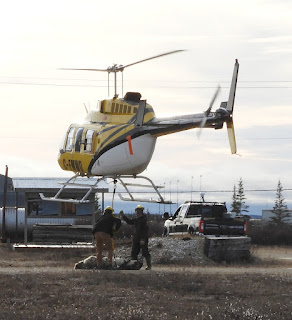 |
| tranquilized cubs awaiting transfer to helicopter |
A decade ago, polar bears that wandered into Churchill would be shot. A horrible outcome for a hungry bear seeking food after months of fasting on the tundra during the summer when there is no pack ice for hunting seals, the polar bears’ food.
 |
| preparing mother bear for transfer |
To make things worse, Churchill had a town dump where bears
congregated to search for food. When the
town finally decided to close the dump and bury or haul out the trash by rail,
it took several generations of bears before the memory of food at the dump
faded. Meanwhile, over the last 10
years, the bear population around Churchill, now 852 bears, declined from 1000
bears, a disastrous drop in population brought on by starvation and shooting
wayward bears. Because of global
warming, polar bears now fast for 6 weeks longer than they used to, leaving
them weakened and very hungry by late fall.
They live off the fat they accumulate during the winter hunting seals.
 |
| hauling cub to helicopter |
Now, bears that venture into town are captured in a trap and taken to the “bear jail” just outside of town. There they are not fed (they aren’t eating anyway), but are given a little water, and “trained” to think they would be better off on the tundra instead of in town. Other bears, particularly repeat offenders, are tranquilized and carried off by helicopter 40 or 50 miles away, but still in their territory.
We got lucky and were able to watch one of these transfers of a mother polar bear and her 2 cubs. All were tranquilized with a dart that injects a sedative lasting one hour, so everyone has to work fast. The mother bear was wrapped up carefully in a net that would be securely fastened to a tether hanging down from the helicopter. The babies (quite large) were carried by attendants like giant pandas and placed in the seats inside the helicopter. Cubs are always moved with their mothers, never separated.
 |
| loading cub in helicopter |
Once the cubs were inside, the pilot lifted the helicopter
about 10 feet off the ground so the mother could be attached. Then, off they went with cubs inside and
mother swinging gently below. Despite
the tranquilizer, this is a traumatic experience for the bears, so they cover
their eyes to keep them from being even more frightened.
 |
| attaching mother bear in sling |
A second helicopter accompanies the one with the bears to make sure all goes well at the drop off site. The rangers land and stay with the bears until they wake up and run off, protecting them from any predators and making sure they have no ill effects from the tranquilizer.
The transfer costs $10,000 per event, paid for by a combination of private and public funds. Both Natural Habitat, our tour company, and their partner, the World Wildlife Federation, provide funds for these transfers, along with the Canadian government.
 |
| transfer of bears underway |

No comments:
Post a Comment